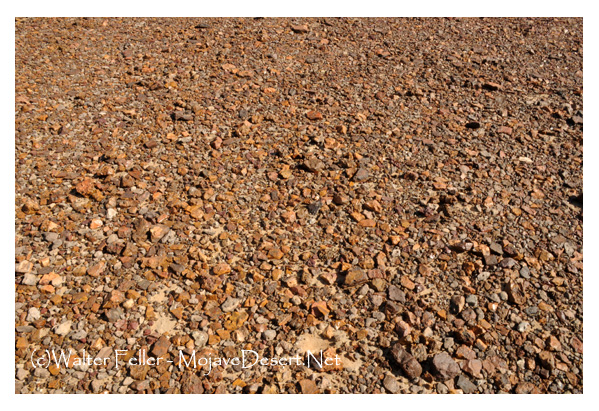TOP -- A B C D E F G H I J K L M N O P Q R S T U V W X Y Z
Desert Pavement

A surface layer of closely-packed, loosely cemented pebbles and cobblestones where the wind has swept away all smaller particles.
Deflation armor
Deflation surfaces, also called deflation armor, desert pavement, deflation crusts, armoring, or several dozen other comparable terms can be recognized as a layer of rocks and pebbles covering the ground surface over finer sediments. These surfaces form through erosion processes, mainly wind weathering.
To quote the experts: "The source of the clasts in the pavement is mechanically weathered basaltic bedrock derived from topographic highs. Salt-rich eolian fines accumulate in fractures of the basalt, and the wetting and drying of the fines results in volumetric changes related to crystal growth or shrinking or swelling of clay. This volumetric change enhances fracturing and displaces clasts vertically and laterally. As displacement occurs, additional eolian fines and salts are deposited between the clasts, further enhancing separation of the clasts from the underlying bedrock. Mechanical weathering of topographic highs also results in the development of colluvial wedges of rubble and contaminant infilling of topographic depressions with the colluvial material. These clasts move laterally by colluvial and alluvial processes into the topographical lows in which abundant silt has accumulated, and they form a surface layer or armor of stones." (McFadden et al., 1987)
Paraphrased in English: The wind deposits salt and clay into cracks in the rocks on high places. As that clay and salt gets wet, it expands and cracks the rocks more. Then when it dries out, it shrinks again, making room for the wind to deposit more salt and clay. This process of expansion and shirking eventually breaks small stones off of the surface of the bedrock. These stones roll down the hill and settle on top of lower places that are already full of dirt. The wind blows away the sand and dirt from on top of and around these stones. However, since these stones are too big for the wind to blow away, they remain and eventually form a surface armor completely covering the finer dirt. It's called deflation because as the wind blows away the sand and dirt from around these stones, they settle and it appears as if the land's surface is gently sinking or deflating. (
REFERENCES
McFadden, L.D., Wells, S.G., and Jercinovich, M.J., 1987, "Influences of eolian and pedogenic processes on the origin and evolution of desert pavements": Geology, v. 15, p. 504-508
Deflation Surfaces on Eastern Santa Cruz Island - Elanor Bartolomeo, Bridget Tracy & Robyn Suddeth
The Mojave Desert - Shaping the Classic American Desert
Bajadas are capped with desert pavement, composed of gravel and small rocks, overlaid with delicate desert varnish--thin clay and other particles cemented to ...
Topock - Mystic Maze
Dark vanished desert pavement on terrace lobes is covered with windrows that stop before the margin of the terrace and rarely cover all of the terrace surface ...
Stream Terraces and Older Surfaces - Mojave Preserve - California ...
Desert landscape and surface processes study, Mojave National Preserve. ... A desert pavement (a surface gravel deposit of tightly packed pebbles, layered just ...
Mojave Desert Petroglyphs
Petroglyph photos, rock art in the Mojave Desert. ... Itaglios are usually made by removing rocks or otherwise incising the design into the desert pavement.
Introduction to Geology of the Mojave Desert
Since the Precambrian Era, the Mojave Desert has experienced many .... the protective layer of desert pavement and promote erosion of fragile desert soils.
Desert Tortoise
The range of the desert tortoise includes the Mojave and Sonoran deserts in ... from sand to sandy-gravel, though caliche soils, desert pavement, and rocky, ...
Pediments and Alluvial Fans - Mojave Desert
Large areas within the Mojave Desert are pediment surfaces. ... In the foreground , a relatively stable alluvial fan surface consists of desert pavement broken by ...